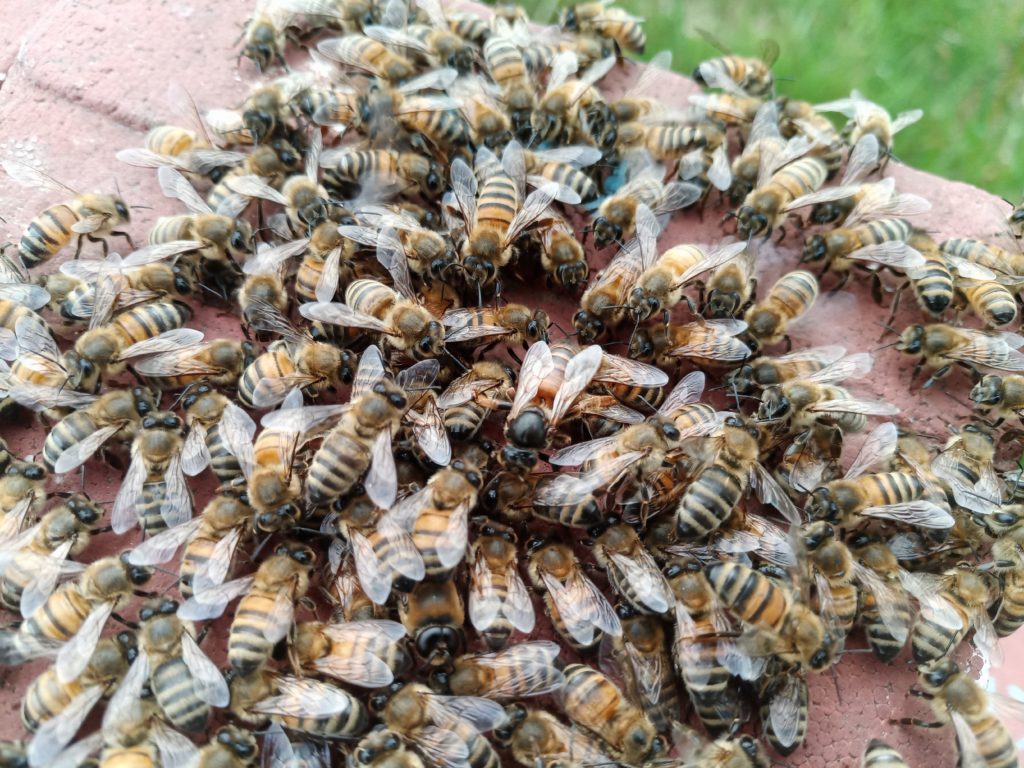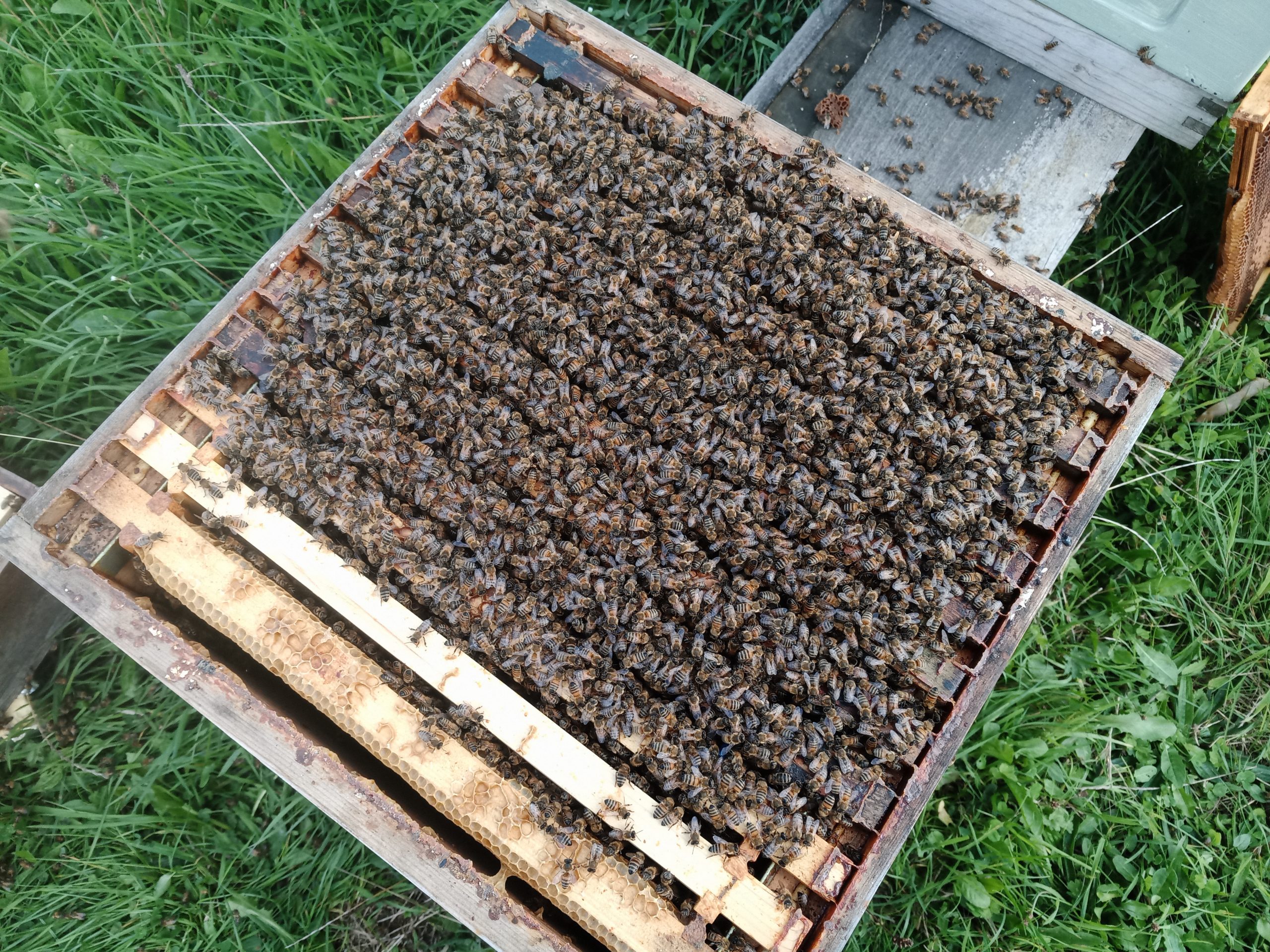The natural behaviours of a honeybee colony and the individuals within
Honeybees are a eusocial insect, this means that they are truly social and dependant on one another for survival. Therefore, they must operate as a unit for common survival and group reproduction. From a beekeeping perspective, undoubtedly, we must be aware of a colony’s life objectives, to survive and to reproduce.
By learning about the natural behaviours of a honeybee colony we can improve our understanding of beekeeping. Since Honeybees are a naturally organised and adaptable insect, their structured behaviour gives them an appearance of high inelegance. However, the reality is that they have evolved many behavioural cycles which allow them to respond quickly to stimuli as a unit. In simple terms, the colony has built in reflex behaviours, much like the reflex point on our knees which cause our leg to twitch when knocked.

The Honeybee nest (Beehive)
Although the colony consists of individual organisms, it is often easier to think of them as a single entity when trying to understand their behaviour. Whilst the individuals are important to the make-up of the colony, it is the common purpose which drives their behaviour. Honeybees alter their immediate environment to suit their needs. This is similar to that of humans, though on a much reduce scale. Therefore, their immediate environment or nest becomes the colony living space. Within beekeeping, this is within a hive which allows us the ability to manipulate their behaviour.
To learn a bit about the individuals within a colony, please visit our Keeping Bees page for a general overview.
Honeybees transform their environment by building storage cells from bees wax in an organised manner. These cells vary in size to allow for change of function dependant upon a colony’s needs. We define them by two average sizes, worker cells (The smallest) and drone cells (the largest). These terms are used as workers are generally raised in worker cells and drones in drone cells. The majority of cells will be worker cells with larger drone cells towards the outer edges. Under exceptional circumstances, honeybees will form queen cells which have the singular purpose of raising a queen bee. The beeswax cells form sheets, comb, and provide the foundation of an insect ‘city’. Each cell provides ‘real estate’ to carry out and fulfil the needs of the colony.
The space within the nest is used by the bees in a predictable fashion. As honeybees are highly responsive due to their reflexive behaviours, we can predict how they will use space. The worker bees, which make up the majority population, distribute themselves throughout the colony in order to maintain it. In turn, they effectively divide up the colony into sections. These sections will have use for different tasks and functions.
Makeup of the Honeybee nest
A honeybee nest is used by the bees in a fluid manner. At the core of the colony is the brood nest, this is the area given over to raising more bees. This area will expand and contract as well as moving up and down vertically. These movements will all be in response to external and internal stimuli. The bees will use the rest of the nest relative to the brood nest. At its furthest expanse, the brood nest will incorporate a portion of the larger drone cells. Only whilst the brood nest is sufficiently large enough will the queen be able to lay in these cells to produce drones.
Moving outwardly from the brood nest, we will then find the storage areas. Here honeybees will store pollen, closest to the brood area. This protein rich resource is important for brood rearing as well as colony health. It’s close proximity aids the efficiency of brood feeding. Next will be active food reserve. This will be a mix of nectar and honey in constant use. This food will aid the raising of brood and be help adult bees to stay ‘well-fuelled’. Above the brood nest is the long-term food store. This is the area for excess honey which will provide food during a dearth. As this store grows in size, it will naturally push the brood area lower down the combs. During the dearth the long-term stores provide food and the brood area moves vertically upwards.

From this brief description you can start to see how internal and external stimuli result in change within the colony and nest. This occurs on a large scale with many behavioural cycles working simultaneously. It is these behavioural cycles which we observe as complex behaviour.
A stimulus trigger starts the behavioural cycle, the bees then proceed with the first stage which results in the foundation work and the stimulus for the next part. This sequence continues until the cycle result is complete or the required stimulus is not present. Where a stimulus is not present part way through a cycle, it will be abandoned, the work the bees have done will be dismantled or repurposed.
Colony Behavioural Cycles
Colony behavioural cycles are, in essence, pre-programmed group response. Whilst this is a simplistic it is broadly accurate. They are responsive to several stimuli which can alter their presentation, yet they will always follow the same general response. It is this unified behaviour which allows honeybees to be so responsive to their environment and so adaptive. It removes the need for complex organisational checks and co-ordination and relies on group unity and survivability.
There are many behavioural cycles and to detail them all would be a large undertaking (maybe we’ll write a book one day). Here are just a few known behavioural cycles, our understanding of them varies, though we do know the general details.
- Yearly growth cycle
- Colony Reproduction – Swarming
- Individual Reproduction – Brood Rearing
- Foraging
- Supercedure
- Worker Job Distribution
- Colony Defence
Learning how these behavioural cycles work allows us to add and remove stimuli and manipulate colony behaviour. This is the most valuable beekeeping tool as it gives the beekeeper control over the colony.

